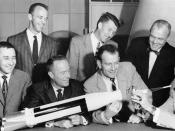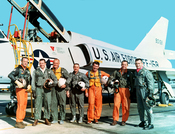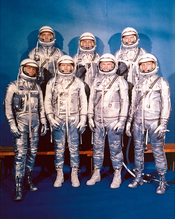Brief overview of the accomplishments of the Mercury missions. Excellent Work. Good Research and Facts.
Project Mercury, the first manned U.S. space project, became an official NASA program
on October 7, 1958. The Mercury Program was given two main but broad objectives: 1. to
investigate man's ability to survive and perform in the space environment and 2. to develop basic
space technology and hardware for manned space flight programs to come.
NASA also had to find astronauts to fly the spacecraft. In 1959 NASA asked the U.S.
military for a list of their members who met certain qualifications. All applicants were required to
have had extensive jet aircraft flight experience and engineering training. The applicants could be
no more than five feet eleven inches tall, do to the limited amount of cabin space that the Mercury
modules provided. All who met these requirements were also required to undergo numerous
intense physical and psychological evaluations.
Finally, out of a field of 500 people who met the
experience, training, and height requirements, NASA selected seven to become U.S. astronauts.
There names, Lieutenant M. Scott Carpenter; Air Force Captains L. Gordon Cooper, Jr., Virgil
"Gus" Grissom, and Donald K. "Deke" Slayton; Marine Lieutenant Colonel John H. Glenn, Jr.;
and Navy Lieutenant commanders Walter M. Schirra, Jr., and Alan B. Shepard, Jr. Of these, all
flew in Project Mercury except Deke Slayton who was grounded for medical reasons. He later
became an American crewmember of the Apollo-Soyuz Test Project.
The Mercury module was a bell shaped craft. Its base measured exactly 74.5 inches wide
and it was nine feet tall. For its boosters NASA chose two U.S. military rockets: the Army's
Redstone, which provided 78,000 pounds of thrust, was used for suborbital flights, and the Air
Force Atlas, providing 360,000 pounds of thrust,


